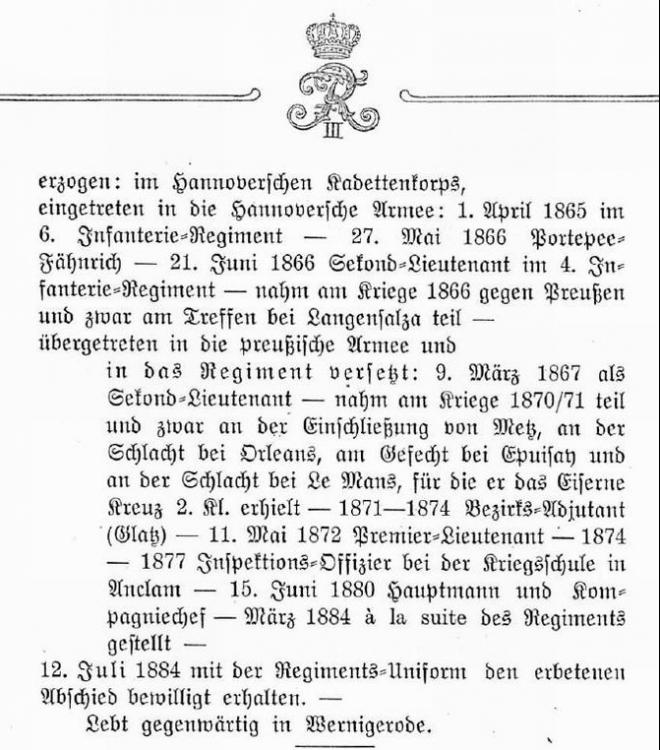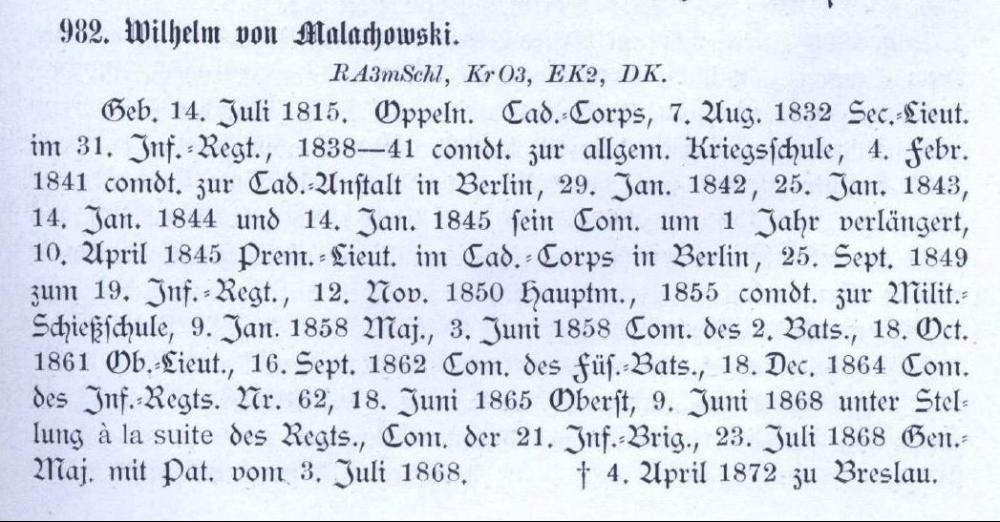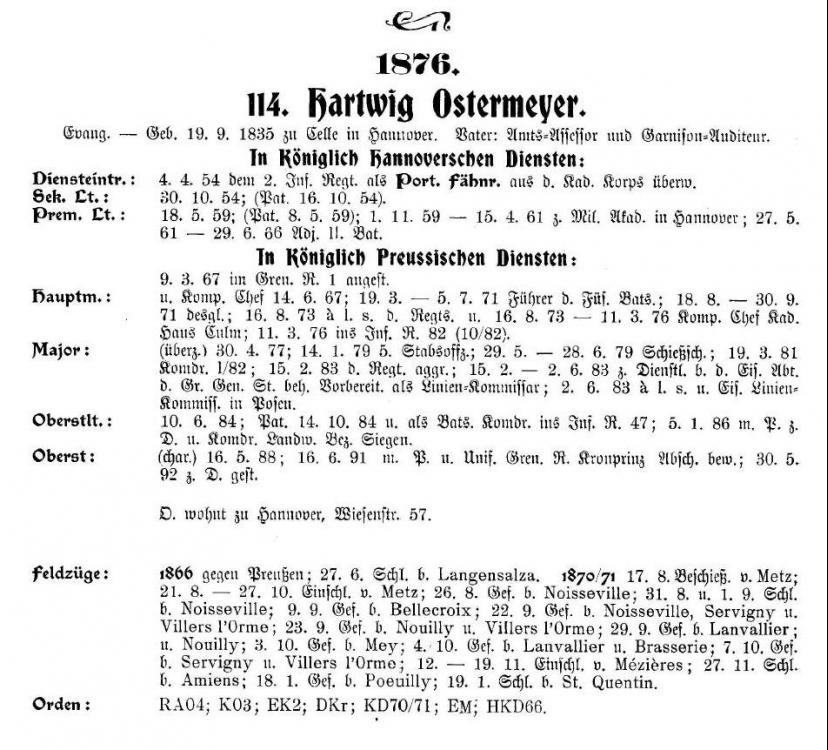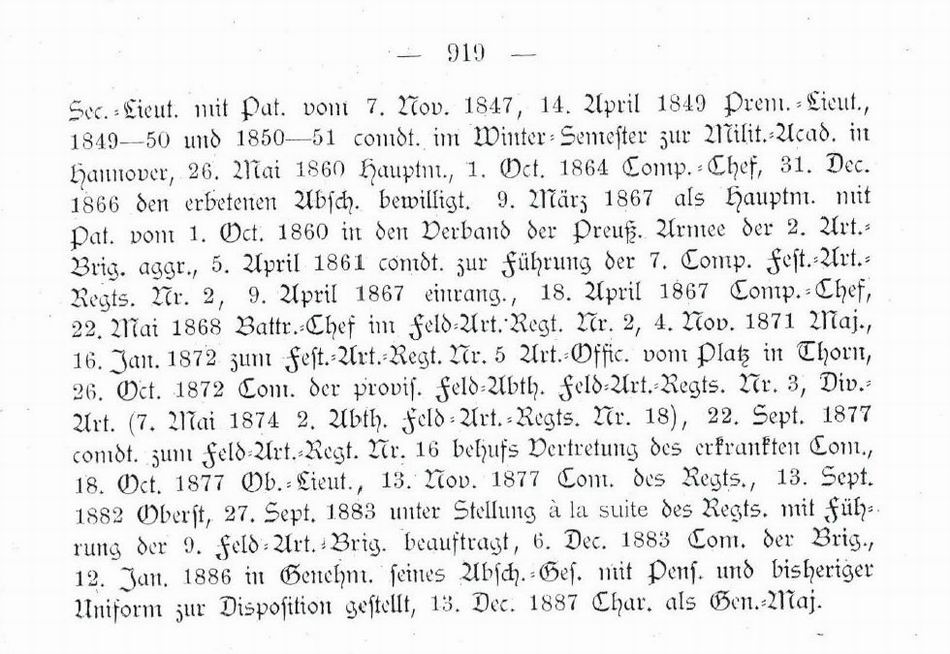-
Posts
2,234 -
Joined
-
Last visited
-
Days Won
55
Content Type
Profiles
Forums
Blogs
Gallery
Events
Store
Everything posted by Glenn J
-
Timo, I think we can safely assume that this is not Robert Burnside. This chap very much appears to be a Leutnant in Grenadier-Regiment Nr, 119 and no officer of that name, either active or reserve served in the Württemberg Army Corps during the period 1894-1898 (or Prussian, Bavarian or Saxon Armies for that matter). Or as Chris says, Burnside in fancy dress. Regards Glenn
-
Herr Graalfs first appears in the navy list in 1895 as a Vizesteuermann der Reserve (Senior reserve officer aspirant) in the II Seamans' Division. He was under the military control of Landwehrbezirk (the military authorities for recruitment and reservist matters and control) II Oldenburg. He was commissioned as an Unterlieutenant zur See der Reserve with a Patent (seniority) of 18.6.95 B. Promoted to Lieutenant zur See der Reserve with a Patent of 16.11.98 F. The title of rank was restyled to Oberleutnant zur See der Reserve in 1899. He was promoted to Kapitänleutnant der Reserve with a Patent 17.5.04 K and transferred from reserve to Seewehr (2nd line) service in 1905/1906. He was never a career naval officer and would have been a "one year volunteer" in the navy to fulfil his military obligation before obtaining a commission in the reserve. It would appear from the naval "Ehrenrangliste" that he was a prisoner of war throughout WW1 having been interned in Havana. The LD2 was normally awarded for exemplary service on completion of the requisite time in service in the reserve and Landwehr 1st levy, in effect around ten years service. He already held the rank of Kapitän with HAPAG prior to the war. Regards Glenn
-

Award dates of Prinz Leopold von Bayern
Glenn J replied to Ingo's topic in Germany: All Eras: The Iron Cross
Ingo, as a result of the deliberations of the Ordenskapital sitting om 30 December 1870, The King awarded Prinz Leopold the Ritterkreuz of the Militär-Max-Joseph-Orden on 7 January 1871 (effective 1 December 1870). The order was published in the Bavarian Militär-Verordnungsblatt No 6 of 26 January 1871 per order dated 25 January 1871. Regards Glenn -

Award dates of Prinz Leopold von Bayern
Glenn J replied to Ingo's topic in Germany: All Eras: The Iron Cross
Ingo, the award of the EK2 was gazetted in the Bavarian Militär-Verordnungsblatt No 53 of 30 September 1870. Royal permission was given to wear the decoration by the King of Bavaria on 26 September 1870 and promulgated by an order dated 29 September 1870. The award of the EK1 was gazetted in the Bavarian Militär-Verordnungsblatt No 5 of 24 January 1871 with Royal permission to wear the decoration by the King of Bavaria given on 18 January 1871. Regards Glenn -
Dave, it is something I am looking into but I get the impression that although one pretty much automatically earned the right to the continued wearing of uniform on retirement after serving the requisite number of years, the officer still had to formally apply, and I assume that he would choose the regiment he felt the most affinity towards. Regards Glenn
-
Chris, as a general rule, officers who had served 10 years active duty would be granted the permission to wear the "Army Uniform", that is a non unit specific uniform. Those who had served 15 years would be granted the authority to wear "Regimental Uniform" as would those who had served a lesser period but were retired on account of wounds received during wartime. Generals including brevet major generals were always granted the permission to wear the generals' uniform with "inactive status" insignia. In the case of Reserve and Landwehr officers the qualifying periods for the two distinct types of uniform was 20 and 25 years respectively. As you surmise, worn as spectators at parades, Feiertagen and the like. Regards Glenn
-
Bruno v. Rüdgisch, born 12 November 1854 in Rüdigheim, was a retired Prussian cavalry Rittmeister and squadron commander in Dragoner-Regiment Nr. 1. He left Prussian service in 1899 as a char. Major. z.D. and entered Ottoman service, rising to the rank of Lieutenant-General and Inspector of cavalry. He returned briefly to Prussian service in 1909 and retired as an Oberstleutnant in Dragoner-Regiment Nr. 22 the same year. Living in Berlin in 1913, I find no indication that he served during WW1. Regards Glenn
-

Official. A necessary help is on a rank and department.
Glenn J replied to Sommerfeld's topic in Austro-Hungarian Empire
Gordon, the uniform is shown in a photograph on page 23. Illustrations from the regulations to include the service dress jacket and shoulder boards are on page 30 and 31. Rank classes are discussed on pages 17 and 18 and specific rank insignia according to grade on page 21. Regards Glenn -

Official. A necessary help is on a rank and department.
Glenn J replied to Sommerfeld's topic in Austro-Hungarian Empire
Jörg C. Steiner illustrates this uniform in his "Uniformen und Blankwaffen der Staatsbeamten und der Bundesbeamten 1848-1938". As already alluded to, this gentleman is an official in an Austro-Hungarian Ministry and holds the rank of an official of the 4th Category, 3rd Grade (Vierte Kategorie, dritter Grad), that is an official of the 11th rank class (the lowest). The uniform accords to that of the 1889 uniform regulations. Regards Glenn









